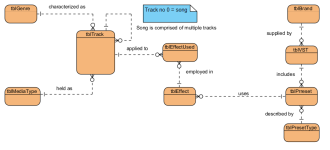I am on iteration 5 of trying to create a database where I can store details for music I write using Cubase Software and other instrument/effect programs. I beginning to believe that it is my table structure and relationships that are causing my forms to not work as expected. Below is a brief description of what I need and a relationships report showing my tables and relationships. I would appreciate any feedback on where I might be getting off on the wrong foot with my table designs.
1 Song has many Tracks(Instruments) that make up the song.
1 Song may have many Effects.
1 Track(Instrument) may have many Effects.
Instruments and Effects are "VST" programs that either produce music (instrument) or alter the instrument (effect). Some VST's can do both, most are dedicated to either making sounds or altering sounds.
An Instrument or an Effect is assigned a Preset name after the VST's settings are set. (There are thousands of presets. So, I want to be able to filter the presets by the Software Company (Brand), the Software Name (VST), and the Software Type [Effect, Instrument, Audio Clip, etc.])
There are one-many and many-many relationships here.
I don't want to get into the forms before I am confident my table structure and relationships are accurate.
I would appreciate feedback on what I have so far.
1 Song has many Tracks(Instruments) that make up the song.
1 Song may have many Effects.
1 Track(Instrument) may have many Effects.
Instruments and Effects are "VST" programs that either produce music (instrument) or alter the instrument (effect). Some VST's can do both, most are dedicated to either making sounds or altering sounds.
An Instrument or an Effect is assigned a Preset name after the VST's settings are set. (There are thousands of presets. So, I want to be able to filter the presets by the Software Company (Brand), the Software Name (VST), and the Software Type [Effect, Instrument, Audio Clip, etc.])
There are one-many and many-many relationships here.
I don't want to get into the forms before I am confident my table structure and relationships are accurate.
I would appreciate feedback on what I have so far.

